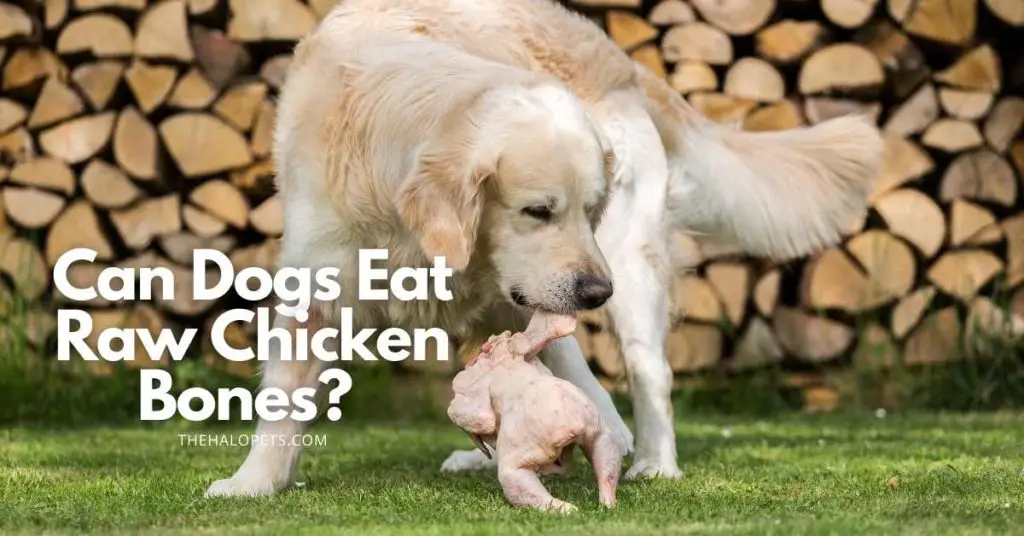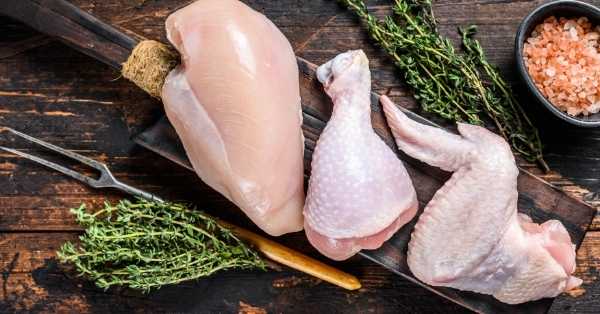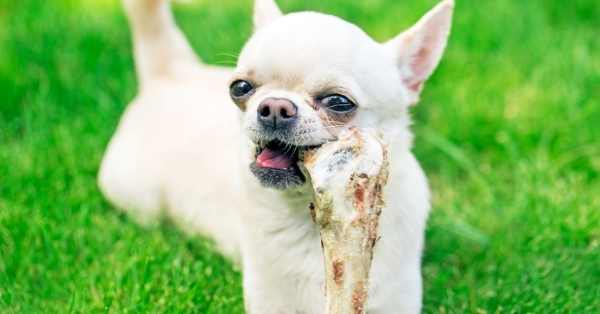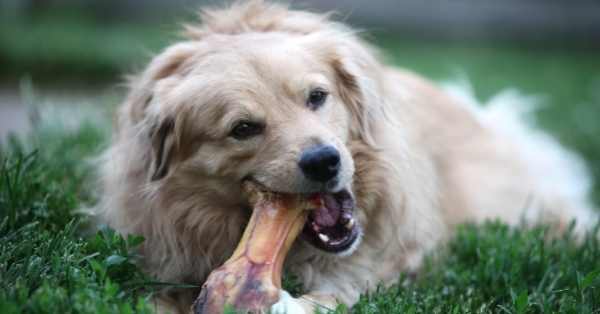Your dog is looking at you with puppy eyes, eyeing your leftover raw chicken bones while you are cooking. He’s been so good lately, and you want to give him a treat. But are chicken bones good for dogs? Can dogs eat raw chicken bones?
In this article, we’ll learn about
- Can Dogs Eat Raw Chicken Bones?
- How much raw chicken bones can you serve your dog
- And more…

Can Dogs Eat Raw Chicken Bones?
Raw chicken bones are healthy for dogs to consume. Raw chicken bones provide essential nutrients to cleanse a dog’s digestive tract and provide other health benefits such as a lustrous coat and a clean and healthy dental system. Do not feed cooked bones to a dog as it may cause internal bleeding.
Usually, you may have heard people advising not to feed dogs bones, and this might probably be because of fear and misconception that dogs can swallow or break their teeth while gnawing the bone.
But such drastic scenarios are only a myth.
In reality, feeding your dog chicken bones improves their oral health while also increasing their metabolism, allowing them to digest food more easily and rapidly.
For now, it is safe to assume that feeding dogs bone actually aids in improving their health stature.
Now rises the next doubt, whether should you feed cooked or raw bones to your pups?
Without a doubt, raw bones.
According to Dr. Adam Sternberg from Greencross Vets Brookvale, raw bones are the best option for dogs since cooked bones can be brittle and can be easily broken while chewing, causing fractured teeth, splintering, and many more.
So, for dogs, raw bones are definitely the best choice.
However, it is essential to note that not all bones are appropriate for dogs, as there is a risk of adverse effects from consuming bones.
Which Bone Parts Of The Chicken Should I Feed My Dog?

There are a few things to consider when deciding which chicken bones to feed your dog. The biggest thing is the size of the bone. Smaller bones are easier for dogs to chew and digest, while larger bones may pose a choking hazard or be too difficult to digest properly.
If you are looking forward to feeding raw chicken bones to your dogs, you can give them.
- Chicken wingtips
- Chicken neckpieces
- Chicken thighs
- Chicken Legs
Also, make sure to leave some meat with the bones while feeding your pups and break them up into tiny, flattened pieces so they can chew and swallow them effortlessly.
Do not feed weight-bearing bones
Feeding your pet weight-bearing bones is not a good idea. Weight-bearing bones are the joints of the body that holds up the weight. Examples are the ankles,knees, hips, pelvis, lower back and spine.
Though some adult breeds will be alright chewing weight-carrying bones, others, particularly young puppies, may be at risk since these bones are difficult to break and can break into tiny pieces and crack teeth if bitten harder.
So it is better to keep the weight-bearing bones or the leg bones away from your little dogs. However, if your dog is an adult and is well experienced in chewing bones, you can give them strong weight-bearing bones.
How To Feed Raw Chicken Bones To Your Dog?

The dread of salmonella is what keeps most dog owners away from feeding their dogs raw bones.
Salmonellosis is an infection found in dogs caused by salmonella bacteria which causes severe illness to dogs such as fever, diarrhea, vomiting, etc.
According to Dr. Jennifer Coates, DVM, salmonella is found in one-fourth to one-half of raw meat diets, including a high number of antibiotic-resistant bacteria. These bacteria are normally found on raw meat and bones and can transmit severe illness symptoms to the dogs and the humans in the household.
So, to avoid any dire consequences, here are some safe ways you can feed your dogs raw meat:
1. When Feeding Your Dog Raw Bones, Keep An Eye On Them
There’s a danger your dog will swallow the bones if he doesn’t chew them thoroughly. Rather than leaving the bones in the dog’s bowl, feed them by holding the bones in your hand.
This will encourage your dog to chew and crunch the bones into small pieces before ingesting them.
After a few trials, your pet will be gradually trained to chew and swallow bones properly.
2. Understand Your Dog’s Chewing Behavior
When you’re feeding your dogs bones, pay attention to how they consume them.
Do they chew and gnaw?
Or are they attempting to devour the bones whole?
Understanding their feeding habits can assist you in selecting the appropriate bone for them.
If your dog tries to swallow bones, you can buy smaller-sized bones, such as raw chicken bones, which can be given in little pieces and do not harm the dog even if ingested.
3. Slowly Introduce Raw Meat To Your Dogs
Dogs who are used to eating kibbles may struggle to adapt to eating bones.
Start slowly and feed the bones along with their regular diet.
When giving your dog a raw diet, you can begin with raw chicken bones. Excess skin should be removed because it can create digestive problems.
For puppies, you can sprinkle the crushed bone powder on their regular meals.
Some good dog food recommendations include Purina Pro Plan, and Blue Buffalo. It is important to get your four-legged friend’s diet correct and nutritious.
4. Separate Multiple Dogs While Feeding Raw Bones
Trying to feed bones one by one to each dog in a multi-pet household can result in an aggressive mess.
Raw bones appear as a huge reward in the eyes of dogs. So feeding one with them might induce possessiveness and aggressiveness.
As a result, it is preferable to feed them raw bones in separate rooms.
5. Wash Your Hands After Feeding Raw Bones To Dogs
It’s also vital to consider your own safety, as well as that of your pets when it comes to safety.
According to the VCA hospital, freezing the raw meat or bones before feeding can reduce the risk of bacteria.
After feeding your dogs, wash your hands thoroughly with quality soap and hot water for at least 20 seconds to eradicate any traces of bacteria.
When handling raw bones, try using a cloth or gloves.
How Much and How Often To Feed Your Dog Chicken Bones?

Feeding dogs with raw chicken bones come with numerous benefits such as:
- Improved oral health
- Improved digestive tract
- Improved physical and mental stimulation.
According to Dr. Shawn Messonnier, DVM, feeding raw bones also enhances your pet’s psychological well-being and overall health.
However, consuming too many bones can cause severe side effects like constipation.
Feeding your dogs one or two bones per week is enough to provide them with all the nutritional benefits they need.
What To Do If My Dog Looks Uncomfortable After Eating Chicken Bones?
As healthy and nutritious chicken bones are for dogs, the positive results are however not for every dog.
Some dogs may experience unease after consuming raw bones.
If you notice your dogs acting strangely after feeding them raw bones, there might be a chance that a bone piece is blocked in the digestive tract.
If your dog is experiencing mild symptoms such as vomiting or diarrhea, you can treat them at home with a bland diet such as bread or ordinary kibbles. This way, the ingested bones may mix with the bread or kibbles and do not form an obstruction in the gut.
Some dogs may be allergic to raw chicken meat. Feeding them with raw chicken bones will also result in allergic side effects.
When Do I Need To See A Doctor After My Dog Ate Chicken Bones?
Though a dog’s discomfort after eating bones does not usually indicate something serious, pet owners should be cautious if the symptoms are more severe.
According to Dr. Sandra C. Mitchell, DVM, DABVP, if your dogs exhibit any of the following symptoms, there are chances that a bone piece is stuck in their upper airway or the upper intestinal tract:
- Vomiting
- Diarrhea
- Drooling
- Coughing
- Gagging
- Trouble breathing
There are also chances of your dog exhibiting allergic symptoms like breaking into hives or difficulty in breathing etc.
The symptoms mentioned above are signs that your dog needs immediate help from a vet.
Also Read: Never Feed Your Dog These 30 Food Items!
Can A Puppy Eat Raw Chicken Bones?
Feeding raw chicken bones for adult dogs is perfectly fine.
What about the little ones, though?
Though you would think that feeding puppies raw bones isn’t safe because there’s a danger they’ll break their teeth, feeding raw bones to puppies can assist improve their overall health from a young age.
Instead of feeding the puppies an entire bone, crush it into smithereens.
So you will not have to worry about them getting hurt and feed them with more beneficial nutrients.
How To Feed A Puppy Raw Chicken Bones?
When puppies are around 12 weeks old, they can eat raw bones safely.
Even if the puppies have teeth by the time they are 12 weeks old, it is still best not to feed them bones directly. Instead, grind the raw chicken bones into a powder and provide it to the pets.
Feeding your puppies one or two bones every week is more than enough to boost their nutritional and immunological levels.
What Are The Best Raw Bones For Dogs?
According to Dr. T. J. Dunn, DVM, raw bones are packed with essential nutrients and wonderful calcium and phosphorus sources.
Although raw chicken bones are the most excellent choice of raw bones, there are other raw bone options to consider:
Here are some raw bone recommendations that are healthy for your dogs:
- Beef Knuckle Bones
- Buffalo Knuckle Bones
- Lamb Necks
- Duck Necks
- Duck Frames
- Rabbit Legs
- Ox and pork tail
- Whole Quail
- Lamb Shanks
- Lamb, pork, venison, and beef ribs
When feeding raw bones to your dogs, make sure the bones aren’t too small, as your dog may ingest the smaller parts and develop intestinal obstructions.
Frequently Asked Questions
Can Dogs Eat Raw Chicken Thigh Bones?
Dogs may certainly eat raw chicken thigh bones because they are nutritious and safe to chew. To avoid causing stomach discomfort in your dog, make sure to remove the fatty layer from the thigh bones.
Can Dogs Eat Raw Chicken Necks?
Though there are various misconceptions that raw chicken necks are unsafe for dogs, it is not true. According to Dr. T. J. Dunn, DVM, chicken necks are soft bone that is far safer to feed a dog than other chicken bones.
Can I Give My Dog Raw Chicken Wings?
Only when chicken wings are cooked are they brittle and dangerous to dogs. Chicken wings that haven’t been cooked are fine raw bone options for dogs. Chicken wings are a good source of glucosamine and chondroitin, and chewing promotes the dog’s dental strength more than chew toys.
Can Dogs Eat Frozen Chicken Bones?
Freezing raw chicken bones for two weeks might help eliminate any bacteria that may be present on the bones. Allow the bones to defrost for a few minutes before feeding.
What Is An Alternative To Chicken Necks For Dogs?
If your dog is allergic to chicken necks, you can feed them some alternatives like turkey necks, chicken feet, bully sticks, sprats, and antlers. Feed your dogs the alternate neck bones and observe their reaction. If they are fine showing no allergic symptoms your pup is fine with eating other bone varieties.
Can Dogs Eat Raw Pork Bones?
According to the American Kennel Club, whether cooked or raw, pork bones should never be given to dogs. Although raw pork bones are less fragile, they can splinter, causing bleeding in your dog’s teeth or, worse, causing your dog to ingest small fragments. As a result, raw pork bones should be avoided in a dog’s raw meat diet.

